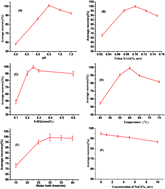Determination of heavy metals in water samples using dual-cloud point extraction coupled with inductively coupled plasma mass spectrometry
Abstract
A dual-cloud point extraction (d-CPE) technique combined with inductively coupled plasma mass spectrometry (ICP-MS) was used for preconcentration and determination of Cr, Ga, Ag, Cd, Mn, Fe, In, Cu, Ni, Co, Pb and Zn in real water samples. An orthogonal array design (OAD) with the OA25 (56) matrix was employed to study the effects of different parameters on the extraction efficiency. Under the best experimental conditions (concentration of complexing reagent 8-hydroxyquinoline, 0.25 mmol L−1; pH, 6.5; equilibrium temperature, 60 °C; surfactant Triton X-114, 0.1%; equilibrium time, 30 min and without salt addition), the enhancement factor ranged from 9.85 to 35.98. The linear dynamic range (LDR) was 1–800 μg L−1 with correlation coefficients of 0.9974–0.9999 and the limits of detection (LODs) were between 0.012 and 0.36 μg L−1. Relative standard deviations (RSDs, C = 10 μg L−1 and n = 6) were 1.29%–5.56%. Finally, the developed method was successfully applied to extraction and determination of the mentioned metal ions in real water samples and satisfactory results were obtained.


 Please wait while we load your content...
Please wait while we load your content...